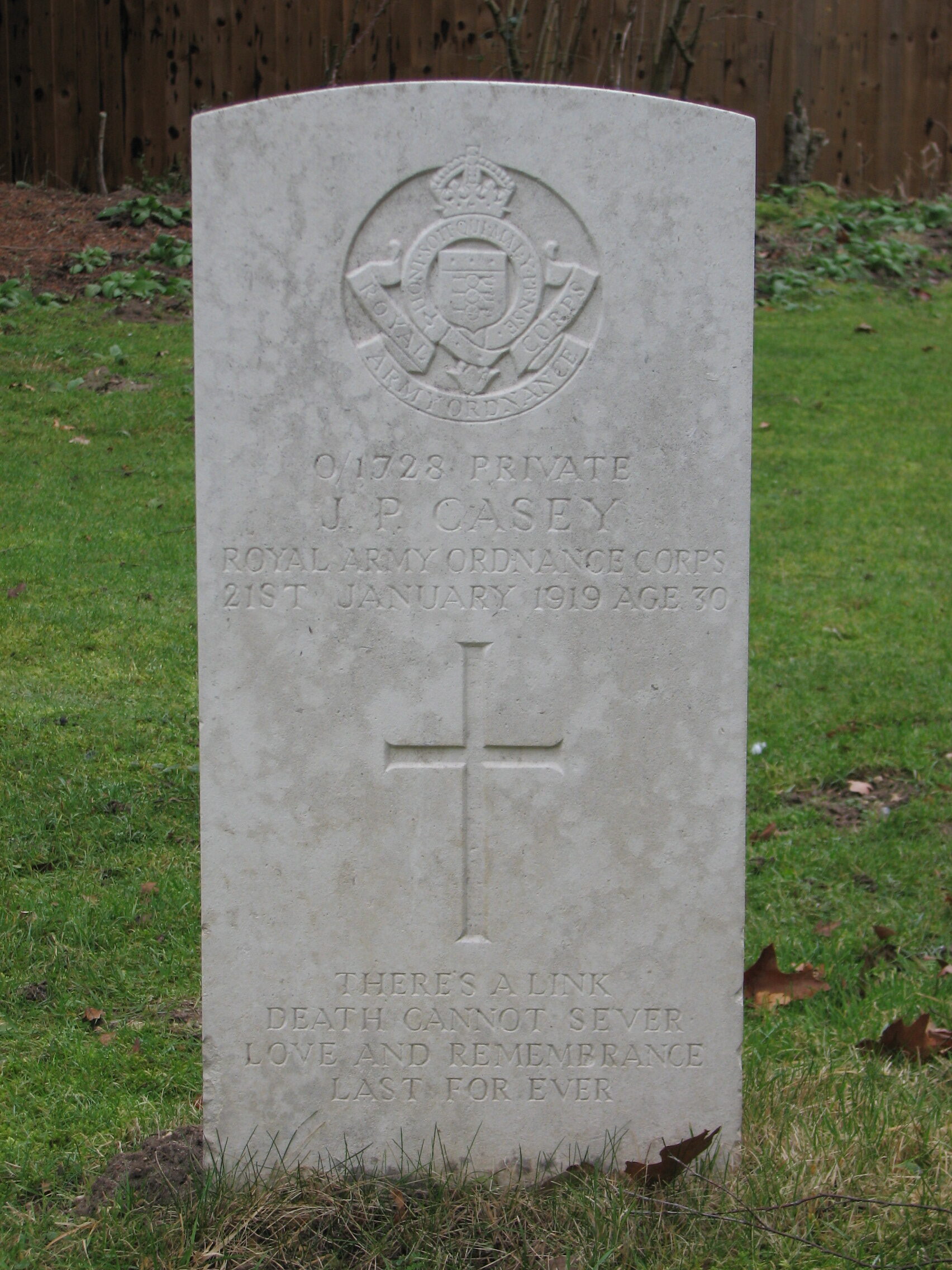John Casey (1887 - 1919)
John spent most of the War serving in the Army Ordnance Corps on the Western Front, before being transferred to Italy in late 1917. He was honourably discharged on medical grounds and died less than a month later.
- 16
- Died in the Great War
- 51.977799, 1.015961
Details
| Name: | John Patrick Casey |
| Service: | British Army |
| Unit: | Army Ordnance Corps |
| Regimental Number: | O/1728 |
| Rank: | Private |
| Age: | 31 |
| Date of Death: | 21st January 1919 |
| Buried: | East Bergholt Cemetery |
Family Background and Early Life
John Casey was born on 5th June 1887 in the Queen Charlotte Hospital, on the Marylebone Road in London.
John’s father Daniel Casey was a Tailor, from Paddington. He had married Marion Beeton Furneaux in 1871, and together they had at least 7 children of whom John appears to have been the youngest. At the time of John’s birth, the family were living on or near the Edgeware Road.
Tragedy struck the family when John was just a small child, both of his parents died within a few years of each other: Marian Casey died in 1889, at the age of 39, and Daniel Casey in 1892 at the age of 51.
What happened to John after his father’s death is not clear, but by April of 1901 he had moved to East Bergholt, where he was living at Hill House on Rectory Hill, the home of John Gibbs and his family. John Gibbs was a Bootmaker, and young John was employed as his Apprentice. The fact that John is also shown as a Servant on the Census Entry suggests that he may have helped as the Gibbs’ family servant at times, as well.
John remained as an Apprentice until 1909 or 1910 when he started working in the Engineering Department – as a Fitters Labourer – at the British Xylonite factory in Brantham. He continued to live as a Boarder at Hill House with the Gibbs family, for at least 2 years before later moving to Portershop Lane (now called Fiddlers Lane).
Volunteers to join the Army
On 9th September 1914, John travelled to Colchester and volunteered to join the Army Ordnance Corps. At the time of his enlistment, he is shown as being 5 foot, 6 and ¾ inches tall, weighing 126 pounds, with a fresh complexion, gray eyes and black hair. He was declared fit for the Army.
The Army Ordnance Corps dealt with the supply, inspection and maintenance of munitions, weapons and associated equipment used by the Army. 1 In 1918, the Ordnance Depot and the Army Ordnance Corps were amalgamated and were granted the ‘Royal’ prefix, becoming the Royal Army Ordnance Corps.
Most of the men of the Army Ordnance Corps were either clerks or storemen (who dealt with the ordering, storage and issuing of the ammunition, weapons and spare parts), or tradesmen (such as smiths, fitters, wheelers, carpenters, saddlers, electricians, welders and armourers) who were responsible for the repair and maintenance aspects.
Given John’s background as Fitter’s Mate in the Engineering Shop at the Factory, it seems very likely that he was employed in the maintenance and repair side of the Corps’ work.
John was posted to join the British Expeditionary Force (B.E.F.) in France, and landed – probably at either Boulogne or Le Havre – on 3rd January 1915.
Unfortunately, no documentation appears to survive which shows exactly which unit John joined in France, so it is impossible to trace his movements over there. We do know that on 8th February 1917, John was on leave in England – though whether this was convalescent leave, or ordinary leave is not clear. On that day, he married May Double at Samford Register Office. May – from Mill Cottage in East Bergholt – was the 23 year old daughter of James Double (East Bergholt’s Coal Merchant) and his wife, Sarah.
Italy
It seems that John went back to France at the end of his leave, though at the end of October 1917 that year he was transferred to Italy as part of the Italian Expeditionary Force (I.E.F.).
The Italian Army had recently suffered a major defeat at the hands of the Austrians and Germans at the Battle of Caporetto, which threatened the collapse of the whole Italian Front. In response to this, the British and French organised a joint military force which was sent to reinforce the Italians.
The British I.E.F. originally consisted of 5 divisions, but 2 of these returned to France in March and April 1918, after the Italian Front had been stabilised. John’s unit belonged to one of the 3 divisions who remained in Italy.
Illness
During his time in Italy John became ill. His illness became so severe that he was sent back to England – disembarking there on 16th September, before being admitted to Colchester General Military Hospital. He was there for seven days, apparently suffering from Influenza, before being transferred to the Military Hospital at Purfleet, Essex where he later developed pneumonia.
In late October, John’s illness was diagnosed as Pulmonary Tuberculosis, or TB of the lungs 2 The doctors later surmised that John contracted the T.B. shortly after he arrived in Italy in November 1917. TB was a widespread, highly infectious disease in Europe during the nineteenth and early twentieth centuries, and was the cause of up to a quarter of all deaths. 3 Classic symptoms of Pulmonary TB include a chronic cough tinged with blood, fever, night sweats and weight loss.
Certainly in John’s case he was very thin by November 1918, and the following month it appears that he may have been transferred to Ipswich fever hospital as a stretcher case.
On 23rd December 1918, Private John Casey was honourably discharged from the British Army under Paragraph 392, (XVI) of the King’s Regulations as he was deemed “no longer physically fit for War Service.
Following his discharge, John was transferred – possibly on a stretcher, as a result of his weakened condition – to the Borough Fever Hospital, on Foxall Road in Ipswich. John died there on 21st January 1919, aged 31 years old. He was laid to rest in East Bergholt Cemetery. 4 John’s age on his gravestone is incorrectly given as 30 years old, when in fact he was 31. Given the events of his childhood, it is perhaps not surprising that the exact year of his birth may have been forgotten.
Copyright © Mark Ashmore, 2024
- 16
- Died in the Great War
- 51.977799, 1.015961


